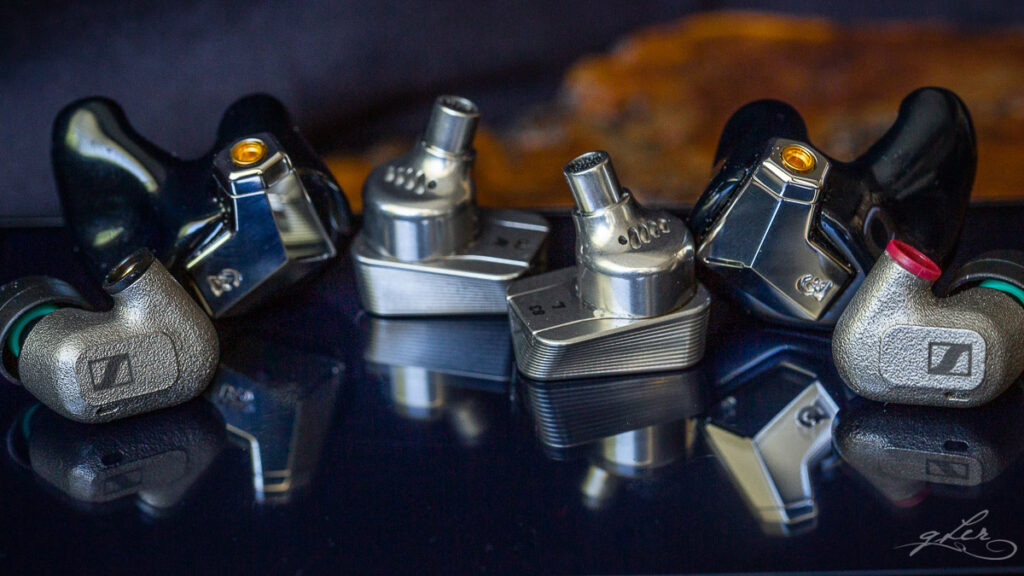Compared to…
Sennheiser IE 600 ($699). Sennheiser’s ‘middle child’ single dynamic driver has been lauded for its balanced tuning and excellent tonality, and while I concur with that appraisal, the IE 600 is also remarkably unremarkable. Unlike Turii Ti, which looks to excite with its mixture of litheness and detail, IE 600 plays it safe, sounding great with everything but exceptional with nothing. Turii Ti is technically also a few steps ahead of the Sennheiser, out-resolving the smaller 7mm dynamic driver by quite some distance and presenting a larger, better-layered stage.
Where Ti doesn’t quite match the Sennheiser is wearability, portability and comfort. Few IEMs can compare with the miniscule IE 600 shells, which seem to disappear in the ear, whereas Turii Ti’s unconventional ergonomics, while not uncomfortable, aren’t exactly the most natural fit either. IE 600 also isolates much better, and so is better suited for listening in louder environments, or where privacy is more important than openness.
Campfire Audio Supermoon ($1,500). The battle of the newer single-drivers, this was the match-up I was most looking forward to ahead of receiving the Turii Ti for review. The first and most obvious difference here is the fit, since my Supermoon is a custom shell and Turii Ti is a tip-wielding universal. Comparing comfort and ergonomics is therefore moot, because universals simply can’t match the effortless wearability and isolation of a good custom.
Sound-wise it’s more complicated, because tonally and technically the two couldn’t be less alike. Where Turii Ti doubles down on natural timbre and balance, Supermoon has a more strident, vivid and occasionally sharp upper frequency tonality that eschews timbral accuracy for liveliness. Their bass presentations are also very different, Supermoon being more elevated and almost infinitely extended in the sub-bass, with more life-size weight and rumble compared to Turii Ti’s mid-bass-forward, more supportive and less impressive lower range.
Technically I find Supermoon to eclipse Turii Ti in most metrics, most notably resolution but also stage size, depth, clarity, layering, separation and speed. Turii Ti images just as well, I’d say, and is also more dynamic.
Both IEMs are inherently ‘musical’ and engaging, with Turii Ti’s strengths lending themselves more to instrumental genres like jazz and acoustic vocal performances, and Supermoon exceling with modern pop, indie and epic orchestral music. Both are excellent with electronic, ambient and modern classical, the differences coming down to tonal preference.

Closing thoughts
It’s been quite an experience getting to know and use Turii Ti over the past few weeks. It’s an IEM with a bold design, outstanding build quality, and accessories that speak to its premium flagship stature. Fit is generally comfortable, and even though the smooth nozzles might impede your choice of tips, most should find tips that work.
At first listen, I was convinced this was the best sounding, most accurate and most technical single dynamic IEM I’ve heard to date, but as testing continued, I found some tonal and technical quirks that didn’t quite work with my library.
For example, I found bass quantity was initially more elevated than early impressions (and the FR graph) suggested, but it turns out the bass was mostly mid-bass biased, which didn’t quite square with my preferences. Sub-bass roll-off was also an issue for me, even though, zooming out, I can understand why Softears tuned it this way – tonal balance above all else.
Technically, while very impressive for a dynamic driver, it still couldn’t match the technical performance of other IEMs, notably the $1000 less-expensive Supermoon. I feel that technical performance, especially stage size and depth, is adversely affected by the overabundant mid-bass on some tracks, but again that could just be the way I’m wired. In any case, if you’re sensitive to mid-bass-biased signatures or mid-treble peaks, keep in mind that it’s possible you’ll hear them like I do.
All of this is to say that, while I find Turii Ti to be an impressive, polished performer, emotional engagement means different things to different people, and I don’t find Turii Ti the most emotionally-engaging IEM I’ve heard. With some music, vocal jazz and some slower acoustic music, I’m in absolute heaven, unable to fault any part of the performance. But switching to some modern pop or indie, and I’m far less enthused.
This is an IEM that will, quite rightly, have its cheerleaders. It certainly demands your attention, rather than just wistfully lulling you to relaxation. It does so much right with so much music, that even if you find the occasional flaw, that shouldn’t break your listening stride. And if your library aligns with its strengths – outstanding timbral accuracy, balanced tonality, and impressive technical performance – you’re in for an absolute treat.
In closing, the $2,500 question: is Turii Ti worth the money? That’s not something I can answer for you, but for me, it doesn’t do quite enough. I’m still quite happy to give them a qualified two thumbs up, but only if, despite the quirks, the sound is exactly what you’re after.




